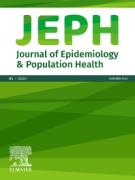One-year post-intervention effectiveness of a proportionate universal intervention in reducing social inequalities of weight status among adolescents - 29/03/25
 , Florian Manneville a, b, Johanne Langlois a, c, Karine Legrand a, b, Elisabeth Spitz a, Philip Böhme d, Edith Lecomte c, Francis Guillemin a, b, Serge Briançon a, Abdou Omorou a, b
, Florian Manneville a, b, Johanne Langlois a, c, Karine Legrand a, b, Elisabeth Spitz a, Philip Böhme d, Edith Lecomte c, Francis Guillemin a, b, Serge Briançon a, Abdou Omorou a, bAbstract |
Introduction |
The effectiveness of interventions in reducing social inequalities of weight status among adolescents is challenging. Studies reporting post-intervention effectiveness are scarce. We aimed to evaluate the 1-year post-intervention effectiveness of PRALIMAP-INÈS (PRomotion de l'ALIMentation et de l'Activité Physique – INÉgalité de Santé) trial.
Methods |
Participants of the PRALIMAP-INÈS trial, a proportionate universal intervention of 1-year in 11–13 years-old children recruited in 35 schools of Nord-Est France which compared socially advantaged to less advantaged children, who had completed data at 1-year (T1) and 2-year follow-up visit (T2=1-year post-intervention) were included. The first group received a standard lifestyle intervention (advantaged with standard care [A.S]) and the second a reinforced lifestyle intervention (less advantaged with standard and strengthened care [LA.S.S]). This proportionate intervention led to similar benefit in the two groups after 1-year of intervention. The present work looked at the retention effect of this proportionate intervention 1-year after the end of the lifestyle program. The main outcome was the change in body mass index z-score (BMIz) from T1 to T2. Between-group outcomes changes analysis involved the t test for equivalence using a Two One-Side Test procedure and hierarchical mixed models. Multiple imputation was performed to handle missing data.
Results |
This study included 505 adolescents (338 in A.S and 167 in LA.S.S groups) of mean age: 15.2±0.7 years. The equivalence was evidenced for BMIz (0.01[90% confidence interval, −0.05 to 0.07]), BMI (0.02[−0.26 to 0.29]), BMI percent of the 95th percentile of Centers for Disease Control and Prevention (CDC) growth chart reference (0.01[−0.94 to 0.96]), BMI minus 95th Percentile of CDC growth chart reference (0.01[−0.26 to 0.29]) and proportion of obesity (−0.01[−0.04 to 0.04]) from T1 to T2 between LA.S.S and A.S. Nevertheless, we did not show significant difference between the two groups for nutrition behaviors outcomes at 1-year post-intervention.
Conclusion |
At 1-year post-intervention, we showed equivalence in adolescents’ weight status changes whatever the socioeconomic class. Therefore, this proportionate universal intervention applied to adolescents in a school setting seems effective to prevent the worsening of the social inequalities of weight status in response to a lifestyle intervention at 1-year.
Le texte complet de cet article est disponible en PDF.Keywords : post-intervention, effectiveness, weight status, social inequalities, adolescents
Plan
Vol 73 - N° 2
Article 202977- avril 2025 Retour au numéroBienvenue sur EM-consulte, la référence des professionnels de santé.
L’accès au texte intégral de cet article nécessite un abonnement.
Déjà abonné à cette revue ?

